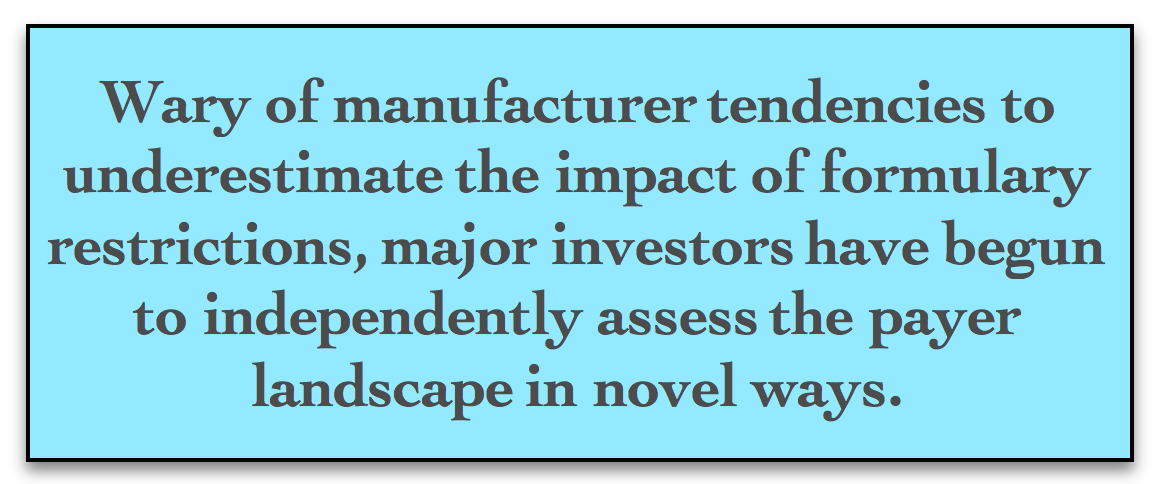For Payer Research, High Stakes are the Mother of All Invention
As payers increasingly stifle new drug launches, investors in biopharmaceutical companies pursue better sources of insights.
In today’s world of biopharmaceuticals, formulary access is often the difference between success and failure. Over the last 10 years, manufacturers have begrudgingly come to accept this fact as payers regularly author unfavorable clinical narratives for any given drug. This has resulted in countless examples of restricted formulary access, unexpectedly high rebates, and missed sales targets. Given this reality, understanding the payer perspective is a critical necessity and has given way to new, transformative approaches to payer research.
Ultimately, manufacturers most want to understand P&T committees. What evidence will they consider and what evidence will they exclude? How do they interpret the key nuances of the various study designs? Are the clinical differences across already approved products meaningful? Unfortunately, gaining reliable insights directly from the secretive P&T committees is not possible... or is it? Selecting the right information sources and then converting those inputs into actionable insights is a substantial challenge. Perhaps nothing speaks to this more than the inherent limitations of advisory boards and interview-based market research. It goes something like this:

A manufacturer chooses to invest ~$250K into gaining payer feedback on a range of topics. The content scope is sound, the line of questioning meticulous and exhaustive, and the potential value easily exceeds the cost. The interviews are carried out to all specifications, the deliverables are well organized and timely, and the insights appear to be highly actionable. Just one problem... a big problem: the panel-the payer “customers” recruited for their study-are not actually payer customers at all. They are retired, do not exert regular influence on formulary decisions, and/or have roles only loosely connected to a payer organization.
Why does this happen? Because quality is relative, and manufacturers have learned to accept these limitations as a necessary evil. Meanwhile, biopharmaceutical investors have identified promising new ways to conduct payer research. Wary of manufacturer tendencies to underestimate the impact of formulary restrictions, major investors have begun to independently assess the payer landscape in novel ways.
First, they forego the stagnant advisory board, directly engaging two primary sources of P&T clinical reviews instead: (1) online, subscription-based software used to create P&T drug evaluations and (2) the drug information centers contracted by payers to conduct their clinical evaluations. Both offer unique vantage points as a source of current, real-world P&T perspectives, and the insights they offer are free of biases typical of standard ad boards. Unlike the various artificial payer environments designed to mimic reality, they are reality.
The effort to develop P&T drug monographs and drug class reviews requires hours of research by experienced clinical pharmacists, and their evaluations serve as the cornerstone of every P&T drug discussion. Within each drug evaluation is a cache of real-world insights such as which studies were included (and excluded), how they were graded, whether relevant guidelines were incorporated and, of course, the recommendations for formulary placement. Needless to say, these insights are essential not only when assessing already approved drugs, but also when assessing the competitive implications within pharma’s pipeline.
After reviewing the results from these real-world assessments, additional context can be ascertained by way of directly engaging those same clinical pharmacists. These retrospective interactions pursue more granular analyses of specific clinical studies, focus on potentially differentiating product labeling, and ask any number of their remaining questions. Far from a one-time event, it is a continuous process of learning and refinement.
Well beyond the substantial investment in the research itself, millions of dollars in favorable formulary access are on the line. In order to estimate future returns, all stakeholders need to know how P&T committees across the US evaluate specific drug classes now. Rather than rely solely on asking panels to answer hypothetical questions, consider innovative ways to harvest actionable insights directly from the real-world.
Nora Tsivgas has over 30 years experience helping pharma navigate the payer space. She can be reached by email at nora@formularyinsights.com.
Applying Porter’s Five Forces to Portfolio Management in Pharmaceutical R&D: A Strategic Roadmap
March 17th 2025The increasing costs and complexity of R&D in the pharmaceutical industry have necessitated the adoption of strategic portfolio management to optimize resource allocation and enhance competitive advantage.
Cell and Gene Therapy Check-in 2024
January 18th 2024Fran Gregory, VP of Emerging Therapies, Cardinal Health discusses her career, how both CAR-T therapies and personalization have been gaining momentum and what kind of progress we expect to see from them, some of the biggest hurdles facing their section of the industry, the importance of patient advocacy and so much more.